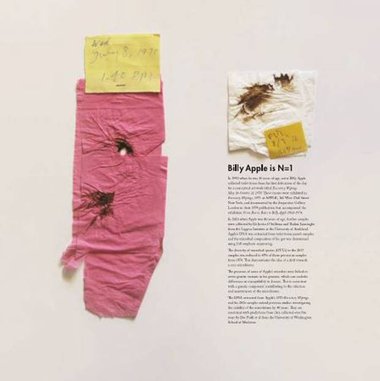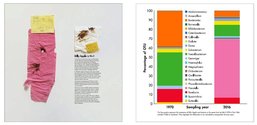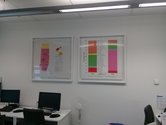John Hurrell – 11 July, 2018
Of interest is how microbe species in the gut change as a person ages (for Apple, the 2016 sample only had 45% of those in the 1970 one), and how they are selected by each person's genetic make-up. In Apple®'s case, the microbes were connected to seven genetic variants in his genome, this being tied to types of susceptibility to disease. The rare 1970 faeces-smeared toilet paper was part of an 'Excretory Wipings May 18-October 21, 1970' project which Apple originally exhibited in New York in 1971.
Auckland
Billy Apple®
N=1
Part of University of Auckland Collection
Over the past decade the conceptual artist Billy Apple has from time to time been involved with art projects that were collaborations with scientists doing medical research. His work with geneticist Dr. Craig Hilton is the most salient example, where Apple donated living cellular material to different institutions to be perpetuated and used in future cancer and immunological research, and genetic analysis. These two links here elaborate on those projects.
Another more recent collaboration examines microbiome, the microbial communities inhabiting the human gut. In 2016 he began a project with Justin O’Sullivan (molecular biologist and geneticist) and Thilini Jayasinghe (human microbiome researcher) who are connected to the Liggins Institute which is part of the University of Auckland. They are interested in how the mix of different species of resident microbe changes over time. For a project that spans 46 years, Apple® provided two samples of used toilet paper (1970 and 2016) to be analysed to see the degree of difference.
Of interest is how microbe species in the gut change as a person ages (for Apple), the 2016 sample only had 45% of those in the 1970 one), and how they are selected by each person’s genetic make-up. In Apple®’s case, the microbes were connected to seven genetic variants in his genome, this being tied to types of susceptibility to disease. The rare 1970 faeces-smeared toilet paper was part of an Excretory Wipings May 18-October 21, 1970 project which Apple originally exhibited in New York in 1971.
That artwork grew out of Apple’s taking on a conspicuous name change in 1962 (he was born Barrie Bates) and acquiring the status of an artwork with its potential attendant processes. All activities executed by his body (such as cleaning windows, removing floor-tile wax, or picking up shattered glass)—and its physical byproducts (like nasal mucus, nose bleeds, earwax, sperm, or faeces)—in the early seventies became artworks too, works that no matter how difficult, could eventually be sold via dealer galleries as conceptual art.
What is interesting is how the 1970’s work is affected by the artist’s change of intentionality between the two pieces of tissue. There is a shift from seventies avant-gardism (anti-bourgeois, confrontational, aggressive and calculatedly disturbing) to the current period where responsible and democratic global community values of collective well-being are being assiduously promoted in an attempt to save all life on the planet. The pugnacious young Apple is being compromised by the much more congenial, gentler, older version who—while still assertive—is now using his provocative four and half decade old artwork to assist medical research, recontextualising and layering it with a new unforeseen respectability.
John Hurrell



 Advertising in this column
Advertising in this column Two Rooms presents a program of residencies and projects
Two Rooms presents a program of residencies and projects



This Discussion has 0 comments.
Comment
Participate
Register to Participate.
Sign in
Sign in to an existing account.